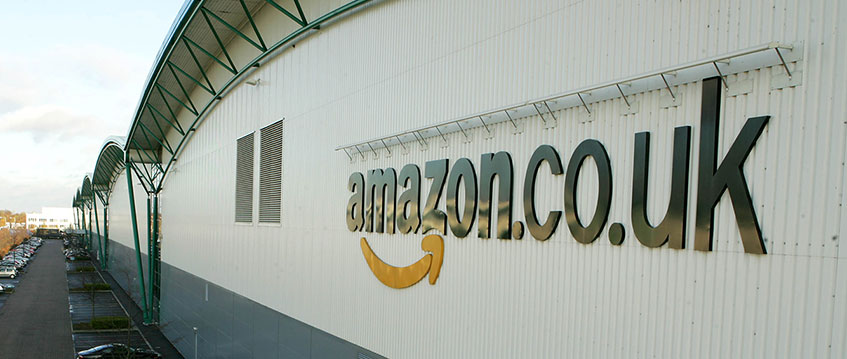Amazon by name, Amazonian by take-up?
If there has been one firm that has flourished throughout the coronavirus pandemic, it is Amazon. As the world went into lockdown, the human need for stuff just could not be curtailed. We wanted to buy and we turned, in our droves, to online.
E-commerce in the UK surged by 129% during lockdown. And while much of the real estate industry slowed to a pause, one occupier was going on the offensive, looking for and acquiring huge swathes of space.
Jeff Bezos’s Amazon reported a 40% increase in sales to almost $89bn (£68bn) in the second quarter of 2020 and saw its net income almost double to reach $5.2bn. It took on 175,000 new employees in the months following the global shutdown caused by the coronavirus pandemic as it rapidly increased its warehouse space and its ability to deliver goods to customers.
If there has been one firm that has flourished throughout the coronavirus pandemic, it is Amazon. As the world went into lockdown, the human need for stuff just could not be curtailed. We wanted to buy and we turned, in our droves, to online.
E-commerce in the UK surged by 129% during lockdown. And while much of the real estate industry slowed to a pause, one occupier was going on the offensive, looking for and acquiring huge swathes of space.
Jeff Bezos’s Amazon reported a 40% increase in sales to almost $89bn (£68bn) in the second quarter of 2020 and saw its net income almost double to reach $5.2bn. It took on 175,000 new employees in the months following the global shutdown caused by the coronavirus pandemic as it rapidly increased its warehouse space and its ability to deliver goods to customers.
Growing footprint
It now plans to grow its global square footage by 50% for the second half of 2020. The growth will eclipse that of 2019, when its footprint grew by 15%. The firm currently has more than 300m sq ft of real estate around the world.
Chief financial officer Brian Olsavsky said the expansion for the rest of this year would include “strong growth in new fulfilment centre space as well as sort centres and delivery stations”.
The firm has also committed to delivering new office space, announcing plans to open 900,000 sq ft in six cities across the US – Dallas, Denver, Detroit, New York, Phoenix and San Diego. In New York it will house some 2,000 workers in the Lord & Taylor Building, a 660,000 sq ft block it bought from WeWork for a reported $1bn in March.
It is also expanding its presence in physical retailing, with plans for as many as 30 Amazon Go convenience stores across the UK, and is in talks with shopping centre owners, offering to take vacant units off their hands to use as Amazon bookstores or “4-star” shops. The 4-star concept sells anything that is rated four or higher on the Amazon website.
Logistics leader
It is in industrial and logistics that Amazon is really showing its dominance.
In the first half of 2020, Amazon accounted for around a quarter of UK logistics take-up, signing for more than 3m sq ft of space, according to Savills.
So far this year the firm has signed for a circa 55,000 sq ft unit in Croydon, south London, has bought a nine-acre site in Mill Hill, NW7, which had been earmarked for a £300m residential scheme, and has signed for more than 1m sq ft of industrial space in the regions – 532,000 sq ft at Hinckley 532 in Leicestershire and 550,000 sq ft at Panattoni Park in Nottingham.
At Mill Hill, Amazon is currently in pre-application discussions with Barnet Council over a fresh scheme for the site. Observers say the site’s location and its proximity to chimney pots could make a compelling case for a new multi-storey distribution facility.
The firm’s dominance of the industrial market in the UK has grown rapidly over the past decade, from an average share of take-up of about 4% to upwards of 20%. And with its stated aim of expanding its footprint by half this year, that dominance is not going to abate.
From spend to space
According to CBRE, every extra £1bn spent online requires some 900,000 sq ft of extra logistics space. Logistics landlord Prologis thinks it is even more. It estimates that 1.2m sq ft of space is needed for every $1bn in e-commerce sales in the US.
Based on that model, the increase in online shopping from around 20% pre-Covid to 33% of all retail sales during the pandemic means demand for warehouse space could top 15m sq ft.
Some of that space could, of course, be provided through the loss of retail space, particularly the demise of department stores and shopping malls.
Amazon has already been quick to pounce and is in early discussions with Simon Property Group in the US to reimagine JC Penney and Sears stores within its malls as distribution hubs. Across its portfolio, Simon Property Group has some 12m sq ft of Sears and JC Penney space – both retailers have filed for Chapter 11 bankruptcy.
With department store chains in the UK also vacating huge swathes of space, could we see landlords make a similar approach to Amazon here?
Not the only game in town
While it would be easy to label Amazon the saviour for vacant space and believe that it is the only occupier taking significant amounts of space at the moment, many in the market are keen to point out that the industrial sector is not dependent on the online giant.
“If you believed all the hype you saw there, you would think it’s all Amazon,” said Prologis chief customer officer Mike Curless in its latest results. “Amazon clearly is ramping up its activity, but we’re seeing definite broad-based activity across a lot of sectors.”
He said demand from home improvement supplies, appliances and food businesses was strong too.
But if Prologis’s maths around the increase in online spend and the consequential need for more logistics space are correct, along with predictions that 80% of all retail spend could eventually end up online, cosying on up to a business that is soon to catch Apple with a $2tn market capitalisation can never be a bad thing.
To send feedback, e-mail samantha.mcclary@egi.co.uk or tweet @samanthamcclary or @estatesgazette
Photo © Nti Media Ltd/Shutterstock











